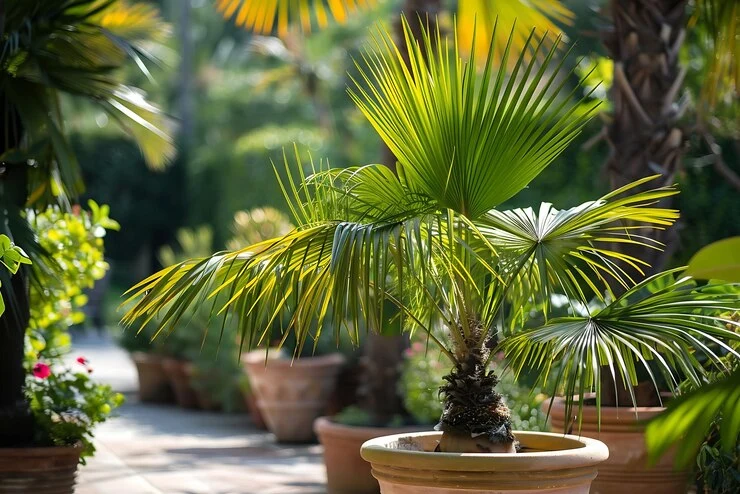Potted palm trees are a beautiful and versatile addition to any home or garden, offering a touch of tropical luxury with minimal effort. Whether you’re looking to spruce up your living room, patio, or office, potted palm trees can transform any environment. Here, we’ll explore everything you need to know about selecting, caring for, and maintaining potted palm trees. We’ll also answer common questions and offer practical tips on how to keep these elegant plants healthy year-round.
Why Choose Potted Palm Trees?
Potted palm trees are popular for many reasons. They add natural beauty, create a serene ambiance, and are relatively low-maintenance. Unlike traditional indoor plants, palm trees offer a larger presence, making them perfect for creating a focal point in any space.
Benefits of Potted Palm Trees:
- Aesthetic Appeal: Palm trees bring a tropical vibe indoors or outdoors.
- Air Purification: Like most plants, palms can help filter and purify the air.
- Low Maintenance: Many varieties require minimal upkeep once established.
- Versatility: Suitable for indoor and outdoor spaces, even in small pots.
Popular Types of Potted Palm Trees
Not all palm trees are created equal. There are various types that thrive in pots, making them suitable for different environments.
Areca Palm
The Areca Palm is one of the most common potted palm trees due to its feathery fronds and adaptability to indoor environments.
Majesty Palm
This variety is ideal for larger spaces. It features long, graceful leaves and needs a bit more attention regarding humidity.
Kentia Palm
Known for its resilience, the Kentia Palm thrives in lower light conditions, making it perfect for indoor use.
Pygmy Date Palm
Compact and easy to manage, the Pygmy Date Palm is great for smaller spaces or patios.
How to Choose the Right Palm Tree for Your Space?
When selecting a palm tree, consider the following factors:
Space
If you have a small space, opt for compact varieties like the Pygmy Date Palm. For larger spaces, the Majesty or Areca Palm might be more suitable.
Lighting Conditions
Certain palms, like the Kentia Palm, can thrive in low light, while others require bright, indirect light. Assess your space before choosing.
Climate
If you’re placing your palm outdoors, ensure it can tolerate your climate. Some palms are more resistant to cold than others.
Best Soil for Potted Palm Trees
Choosing the right soil is essential for the health of your potted palm tree. Palms prefer well-draining soil that allows water to flow through without pooling.
Potting Mix
Look for a high-quality potting mix specifically designed for palm trees. These mixes usually contain sand or perlite to improve drainage.
Organic Matter
Adding organic material like compost can help retain moisture while providing essential nutrients to your palm.
Watering Tips for Potted Palm Trees
Overwatering is one of the most common mistakes people make with palm trees. To keep your palm healthy, follow these guidelines:
Check Soil Moisture
Check if the top inch of soil is dry before watering. If it’s still damp, wait a few more days.
Frequency
Water your palm weekly, or more often if it’s outdoors in hot weather. Be sure to adjust the frequency in cooler months.
Drainage
Ensure your pot has drainage holes. Standing water can lead to root rot, which is detrimental to palms.
Light Requirements for Potted Palm Trees
Most potted palm trees thrive in bright, indirect light, but some varieties, such as the Kentia Palm, can tolerate lower light conditions.
Indoor Placement
Position your palm near a window that receives ample light, but keep it out of direct sunlight to prevent leaf scorching.
Outdoor Placement
If your palm is outside, make sure it’s in a shaded spot, particularly during the hottest part of the day, as excessive direct sunlight can harm the leaves.
Fertilizing Your Potted Palm Tree
Although palms grow slowly, they still require nutrients to thrive. Regular feeding will help them grow stronger and remain healthy.
Palm-Specific Fertilizer
Use a fertilizer specifically designed for palm trees. These usually provide the ideal balance of nitrogen, potassium, and magnesium.
Frequency
Feed your palm every 2-3 months during the growing season (spring and summer). Refrain from fertilizing during winter when the plant is in its dormant phase.
Pruning and Maintenance
Unlike other plants, palm trees don’t need regular pruning. However, removing dead or yellowing fronds is necessary for maintaining a neat appearance.
How to Prune
Only cut off completely brown or yellow fronds. Leave green fronds intact, as they’re still providing nutrients to the tree.
Clean the Leaves
Dust can accumulate on the leaves, especially indoors. Use a damp cloth to wipe them down and keep them clean and healthy.
Common Issues with Potted Palm Trees
Even with proper care, you might encounter some common problems. Here’s how to identify & solve them:
Yellowing Leaves
This could indicate overwatering or a lack of nutrients. Adjust your watering schedule & consider fertilizing.
Brown Leaf Tips
Brown tips often indicate dry air or low humidity. Boost humidity by misting the leaves or using a humidifier nearby.
Pests
Spider mites & scale insects are common pests that affect indoor palms. Manage infestations using insecticidal soap or neem oil.
How to Repot a Potted Palm Tree?
Since palms have a slow growth rate, repotting isn’t required often. However, every 2-3 years, it’s advisable to transfer the palm to a slightly larger container to allow for root expansion.
a. When to Repot
If you see roots emerging from the drainage holes or if your palm has ceased growing, it’s time to repot.
b. How to Repot
Gently take the palm out of its current pot, loosen the roots, and transfer it to a new pot filled with fresh soil. Be gentle, as palm roots are delicate.
Conclusion
Potted palm trees are a fantastic way to bring a slice of the tropics into your home or outdoor space. With their lush, green fronds and minimal care requirements, they’re perfect for anyone looking to add natural beauty to their environment. By choosing the right variety, providing proper care, and addressing any issues promptly, you can enjoy your potted palm for many years to come. Whether you’re a seasoned plant enthusiast or a beginner, these tropical beauties offer both elegance and simplicity.




